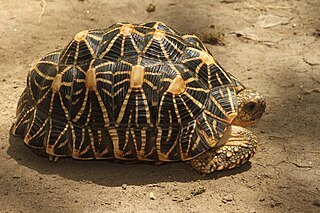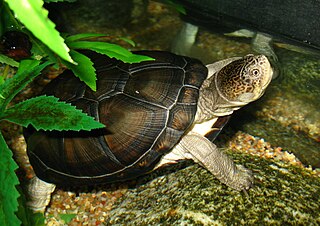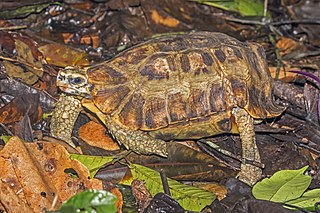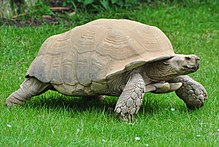
Tortoises are reptiles of the family Testudinidae of the order Testudines. Like other turtles, tortoises have a shell to protect from predation and other threats. The shell in tortoises is generally hard, and like other members of the suborder Cryptodira, they retract their necks and heads directly backward into the shell to protect them.

The ball python, also called the royal python, is a python species native to West and Central Africa, where it lives in grasslands, shrublands and open forests. This nonvenomous constrictor is the smallest of the African pythons, growing to a maximum length of 182 cm (72 in). The name "ball python" refers to its tendency to curl into a ball when stressed or frightened.

The marginated tortoise is a species of tortoise in the family Testudinidae. The species is endemic to Greece, Italy, and the Balkans in Southern Europe. It is the largest European tortoise. The marginated tortoise is herbivorous, and brumates for the winter.

The Aldabra giant tortoise is a species of tortoise in the family Testudinidae. The species is endemic to the Seychelles, with the nominate subspecies, A. g. gigantea native to Aldabra atoll. It is one of the largest tortoises in the world. Historically, giant tortoises were found on many of the western Indian Ocean islands, as well as Madagascar, and the fossil record indicates giant tortoises once occurred on every continent and many islands with the exception of Australia and Antarctica.

The Burmese star tortoise is a critically endangered tortoise species, native to the dry, deciduous forests of Myanmar (Burma). It is close to extinction in Myanmar, as it is eaten by the native Burmese.

The leopard tortoise is a large and attractively marked tortoise found in the savannas of eastern and southern Africa, from Sudan to the southern Cape Province. It is the only extant member of the genus Stigmochelys, although in the past, it was commonly placed in Geochelone. This tortoise is a grazing species that favors semiarid, thorny to grassland habitats. In both very hot and very cold weather, it may dwell in abandoned fox, jackal, or aardvark burrows. The leopard tortoise does not dig other than to make nests in which to lay eggs. Given its propensity for grassland habitats, it grazes extensively upon mixed grasses. It also favors succulents and thistles.

The red-footed tortoise is a species of tortoise from northern South America. These medium-sized tortoises generally average 30 cm (12 in) as adults, but can reach over 40 cm (16 in). They have dark-colored, “loaf”-shaped carapaces with a lighter patch in the middle of each scute, and a somewhat lighter-colored plastron (underbelly). They also have dark limbs dotted with brightly-colored scales, from which they get their name, that range from pale yellow to vivid or dark red. Visible differences are noted between red-footed tortoises from varying eco-regions. They are closely related to the more easterly-distributed yellow-footed tortoise of the Amazon Basin.

The Indian star tortoise is a threatened tortoise species native to India, Pakistan and Sri Lanka where it inhabits dry areas and scrub forest. It has been listed as Vulnerable on the IUCN Red List since 2016, as the population is thought to comprise more than 10,000 individuals, but with a declining trend. It is threatened by habitat loss and poaching for the illegal wildlife trade. It was upgraded to CITES Appendix I in 2019 by full consensus among all member states, giving it the highest level of international protection from commercial trade. Conservation group TRAFFIC found 6,040 were seized globally that were intended to be sold in the pet trade.

Gopherus is a genus of fossorial tortoises commonly referred to as gopher tortoises. The gopher tortoise is grouped with land tortoises that originated 60 million years ago, in North America. A genetic study has shown that their closest relatives are in the Asian genus Manouria. The gopher tortoises live in the southern United States from California's Mojave Desert across to Florida, and in parts of northern Mexico. Gopher tortoises are so named because of some species' habit of digging large, deep burrows. Most notably, Gopherus polyphemus digs burrows which can be up to 40 feet (12 m) in length and 10 feet (3.0 m) in depth. These burrows are used by a variety of other species, including mammals, other reptiles, amphibians, and birds. Gopher tortoises are 20–50 cm (7.9–19.7 in) in length, depending on the species. All six species are found in xeric habitats. Numerous extinct species are known, the oldest dating to the Priabonian stage of the Late Eocene of the United States.

The gopher tortoise is a species of tortoise in the family Testudinidae. The species is native to the southeastern United States. The gopher tortoise is seen as a keystone species because it digs burrows that provide shelter for at least 360 other animal species. G. polyphemus is threatened by predation and habitat destruction. Habitat degradation is the primary reason that the gopher tortoise is listed as vulnerable on the IUCN Red List, but they are considered threatened in some states while they are endangered in others.

Geochelone is a genus of tortoises.

The radiated tortoise is a tortoise species in the family Testudinidae. Although this species is native to and most abundant in southern Madagascar, it can also be found in the rest of this island, and has been introduced to the islands of Réunion and Mauritius. It is a very long-lived species, with recorded lifespans of up to 188 years. These tortoises are classified as critically endangered by the IUCN, mainly because of the destruction of their habitat and because of poaching.

Pelusios is a genus of African side-necked turtles. With 17 described species, it is one of the most diverse genera of the turtle order (Testudines).

The Galápagos tortoise or Galápagos giant tortoise is a very large species of tortoise in the genus Chelonoidis. The species comprises 15 subspecies. It is the largest living species of tortoise, with some modern Galápagos tortoises weighing up to 417 kg (919 lb). They are also the largest extant terrestrial ectotherms.

Kleinmann's tortoise, also called commonly the Egyptian tortoise, Leith's tortoise, and the Negev tortoise, is a critically endangered species of cryptodire turtle in the family Testudinidae. The species is native to Egypt, Libya, and Israel. The species was once more widespread, but its numbers are now dwindling. The species is nearly extinct in Egypt, and complete extinction in the wild is a looming threat unless more actions are taken to protect this species.

The Senegal flapshell turtle is a species of turtle in the subfamily Cyclanorbinae of the family Trionychidae. The species, which is one of two species of softshell turtles in the genus Cyclanorbis, is endemic to Africa.

The yellow-footed tortoise, also known as the Brazilian giant tortoise, is a species of tortoise in the family Testudinidae and is closely related to the red-footed tortoise. It is found in the Amazon Basin of South America. The species name has often been misspelled as denticulata, an error introduced in the 1980s when Chelonoidis was elevated to genus and mistakenly treated as feminine, an error recognized and fixed in 2017.

Home's hinge-back tortoise is a species of tortoise in the family Testudinidae. The species is endemic to Africa.
The Gran Canaria giant tortoise is an extinct species of cryptodire turtle in the family Testudinidae endemic to the island of Gran Canaria, in the Canary Islands.

Centrochelys is a genus of tortoise. It contains one extant species and several extinct species:
























